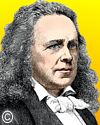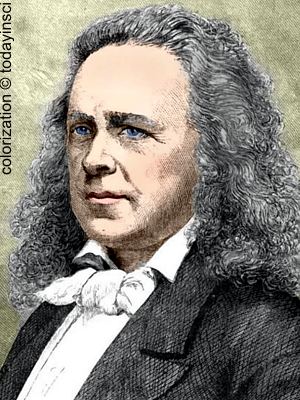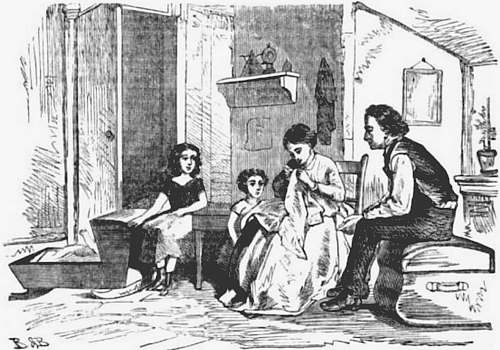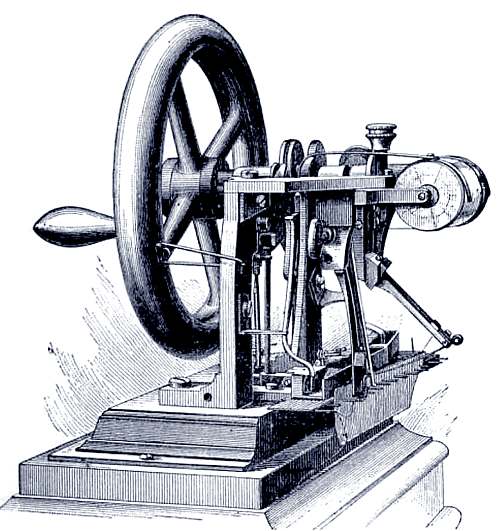 (source)
(source)
|
Elias Howe
(9 Jul 1819 - 3 Oct 1867)
American inventor who developed a commercially successful sewing machine.
|
ELIAS HOWE, Jr.
from Great Fortunes and How They Were Made (1871)
[p.323]

NE of the busiest parts of the busy thoroughfare of Broadway, in the city of New York, is the point of its intersection with Fourth Street. Thousands and tens of thousands of people pass and repass there daily, but few ever pause to look at the curious machine which stands in the window of the shop at the north-west corner of these two streets. This machine, clumsy and odd-looking as it is, nevertheless has a history which makes it one of the most interesting of all the sights of the great city. It is the first sewing-machine that was ever made.
Elias Howe, its maker, was born in the town of Spencer, Massachusetts, in 1819. He was one of eight children, and it was no small undertaking on the part of his father to provide a maintenance for such a household. Mr. Howe, Sen., was a farmer and miller, and, as was the custom at that time in the country towns of New England, carried on in his family some of those minor branches of industry suited to the capacity of children, with which New England abounds. When Elias was six years old, he was set, with his brothers and sisters, to sticking wire teeth through the leather straps used for making cotton cards. When he became old enough he assisted his father [p.324] in his saw-mill and grist-mill, and during the winter months picked up a meager education at the district school. He has said that it was the rude and imperfect mills of his father that first turned his attention to machinery. He was not fitted for hard work, however, as he was frail in constitution and incapable of bearing much fatigue. Moreover, he inherited a species of lameness which proved a great obstacle to any undertaking on his part, and gave him no little trouble all through life. At the age of eleven he went to live out on the farm of a neighbor, but the labor proving too severe for him, he returned home and resumed his place in his father’s mills, where he remained until he was sixteen years old.
When at this age, he conceived an ardent desire to go to Lowell to seek his fortune. One of his friends had just returned from that place, and had given him such a wonderful description of the city and its huge mills, that he was eager to go there and see the marvel for himself. Obtaining his father’s consent, he went to Lowell, and found employment as a learner in one of the large cotton-mills of the city. He remained there two years, when the great financial disaster of 1837 threw him out of employment and compelled him to look for work elsewhere. He obtained a place at Cambridge, in a machine-shop, and was put to work upon the new hemp-carding machinery of Professor Treadwell. His cousin, Nathaniel P. Banks, afterward governor of Massachusetts, member of Congress, and major-general, worked in the same shop with him, and boarded at the same house. Howe remained in Cambridge only a few months, however, and was then given a place in the machine-shop of Ari Davis, of Boston.
At the age of twenty-one he married. This was a rash step for him, as his health was very delicate, and his earnings were but nine dollars per week. Three children were born to him [p.325] in quick succession, and he found it no easy task to provide food, shelter, and clothing for his little family. The lightheartedness for which he had formerly been noted entirely deserted him, and he became sad and melancholy. His health did not improve, and it was with difficulty that he could perform his daily task. His strength was so slight that he would frequently return home from his day’s work too much exhausted to eat. He could only go to bed, and in his agony he wished “to lie in bed forever and ever.” Still he worked faithfully and conscientiously, for his wife and children were very dear to him; but he did so with a hopelessness which only those who have tasted the depths of poverty can understand.
About this time he heard it said that the great necessity of the age was a machine for doing sewing. The immense amount of fatigue incurred and the delay in hand-sewing were obvious, and it was conceded by all who thought of the matter at all that the man who could invent a machine which would remove these difficulties would make a fortune. Howe’s poverty inclined him to listen to these remarks with great interest. No man needed money more than he, and he was confident that his mechanical skill was of an order which made him as competent as any one else to achieve the task proposed. He set to work to accomplish it, and, as he knew well the dangers which surround an inventor, kept his own counsel. At his daily labor, in all his waking hours, and even in his dreams, he brooded over this invention. He spent many a wakeful night in these meditations, and his health was far from being benefited by this severe mental application. Success is not easily won in any great undertaking, and Elias Howe found that he had entered upon a task which required the greatest patience, perseverance, energy, and hopefulness. He watched his wife as she sewed, [p.326] and his first effort was to devise a machine which should do what she was doing. He made a needle pointed at both ends, with the eye in the middle, that should work up and down through the cloth, and carry the thread through at each thrust; but his elaboration of this conception would not work satisfactorily. It was not until 1844, fully a year after he began the attempt to invent the machine, that he came to the conclusion that the movement of a machine need not of necessity be an imitation of the performance of the hand. It was plain to him that there must be another stitch, and that if he could discover it his difficulties would all be ended. A little later he conceived the idea of using two threads, and forming a stitch by the aid of a shuttle and a curved needle with the eye near the point. This was the triumph of his skill. He had now invented a perfect sewing-machine, and had discovered the essential principles of every subsequent modification of his conception. Satisfied that he had at length solved the problem, he constructed a rough model of his machine of wood and wire, in October, 1844, [p.327] and operated it to his perfect satisfaction. His invention is thus described:
“He used a needle and a shuttle of novel construction, and combined them with holding surfaces, feed mechanism and other devices, as they had never before been brought together in one machine. … One of the principal features of Mr. Howe’s invention is the combination of a grooved needle, having an eye near its point, and vibrating in the direction of its length, with a side-pointed shuttle for effecting a locked stitch, and forming, with the threads, one on each side of the cloth, a firm and lasting seam not easily ripped. The main action of the machine consists in the interlocking of the loop, made by the thread carried in the point of the needle through the cloth, with another thread passed through this loop by means of a shuttle entering and leaving it at every stitch. The thread attached to this shuttle remains in the loop and secures the stitch as the needle is withdrawn to be ready to make the next one. At the same time the cloth, held by little projecting pins to the baster plate, is carried along with this by what is called the ‘feed motion’ just the length of a stitch, the distance being readily adjusted for finer or coarser work. … The cloth is held in a vertical position in the machine, and the part to be sewed is pressed against the side of the shuttle-race by a presser plate hinged on its upper edge, and capable of exerting any required pressure on the cloth, according as the adjusting screw that regulates it is turned. A slot, or perforation through the plate, also extended through the side of the shuttle-race near the bottom, admits the passage of the needle; and when this is pushed in the shuttle can still pass freely over it. The shuttle is pushed one way and then the other through its race or trough by picker staves. The thread for the needle is supplied by a bobbin, [p.328] the movement of which is checked by a friction band, this securing the proper tension, and the slack of the thread is duly taken up by a suitable contrivance for the purpose. Thus, all the essential features of the most approved sewing-machine were first found in that of Mr. Howe; and the machines of later date are, in fact, but modifications of it.”
At this time, he had abandoned his work as a journeyman mechanic, and had removed to his father’s house. Mr. Howe, Sen., had established in Cambridge a machine-shop for the cutting of strips of palm-leaf used in the manufacture of hats. Elias and his family lived under his father’s roof, and in the garret of the house the half-sick inventor put up a lathe, where he did a little work on his own account, and labored on his sewing-machine. He was miserably poor, and could scarcely earn enough to provide food for his family; and, to make matters worse, his father, who was disposed to help him, lost his shop and its contents by fire. Poor Elias was in a most deplorable condition. He had his model in his head, and was fully satisfied of its excellence, but he had not the money to buy the materials needed in making a perfect machine, which would have to be constructed of steel and iron, and without which he could not hope to convince others of its value. His great invention was useless to him without the five hundred dollars which he needed in the construction of a working model.
In this dilemma, he applied to a friend, Mr. George Fisher, a coal and wood merchant of Cambridge, who was a man of some means. He explained his invention to him, and succeeded in forming a partnership with him. Fisher agreed to take Howe and his family to board with him while the latter was making the machine, to allow his garret to be used as a workshop, and to advance the five hundred dollars necessary [p.329] for the purchase of tools and the construction of a model. In return for this he was to receive one-half of the patent, if Howe succeeded in patenting his machine. About the first of December, 1844, Howe and his family accordingly moved into Fisher’s house, and the little workshop was set up in the garret. All that winter he worked on his model. There was little to delay him in its construction, as the conception was perfectly clear in his mind. He worked all day, and sometimes nearly all night, and in April, 1845, had his machine so far advanced that he sewed a seam with it. By the middle of May the machine was completed, and in July he sewed with it the seams of two woolen suits, one for himself and the other for Mr. Fisher. The sewing was so well done that it outlasted the cloth.
It has been stated by Professor Renwick and other scientific men that Elias Howe “carried the invention of the sewing-machine further on toward its complete and final utility than any other inventor has ever brought a first-rate invention at the first trial.” Those who doubt this assertion should examine the curious machine at the corner of Broadway and Fourth Street, and their doubts will be dispelled; for they will find in it all the essentials of the best sewing-machine of to-day.
Having patented his machine, Howe endeavored to bring it into use. He was full of hope, and had no doubt that it would be adopted at once by those who were so much interested in the saving of labor. He first offered it to the tailors of Boston; but they, while admitting its usefulness, told him it would never be adopted by their trade, as it would ruin them. Considering the number of machines now used by the tailoring interest throughout the world, this assertion seems ridiculous. Other efforts were equally unsuccessful. Every one admitted and praised the ingenuity of the machine, but no one would [p.330] invest a dollar in it. Fisher became disgusted, and withdrew from his partnership, and Howe and his family moved back to his father’s house. Thoroughly disheartened, he abandoned his machine. He then obtained a place as engineer on a railroad, and drove a locomotive until his health entirely broke down.
With the loss of his health his hopes revived, and he determined to seek in England the victory which he had failed to win here. Unable to go himself, he sent his machine by his brother Amasa, in October, 1846. Upon reaching London, Amasa sought out Mr. William Thomas, of Cheapside, and explained to him his brother’s invention. He found Mr. Thomas willing to use the machine in his business, but upon terms more favorable to himself than to the inventor. He offered the sum of twelve hundred and fifty dollars for the machine which Amasa Howe had brought with him, and agreed to pay Elias fifteen dollars per week if he would enter his service, and adapt the machine to his business of umbrella and corset making. As this was his only hope of earning a livelihood, Elias accepted the offer, and, upon his brother’s return to the United States, sailed for England. He remained in Mr. Thomas’s employ for about eight months, and at the end of that time left him, having found him hard, exacting, and unreasonable.
Meanwhile his sick wife and three children had joined him in London, and he had found it hard to provide for them on the wages given him by Mr. Thomas; but after being thrown out of employment his condition was desperate indeed. He was in a strange country, without friends or money, and often he and his little family went whole days without food. Their sufferings were very great, but at length Howe was able (probably by assistance from home) to send his family back to his father’s house. He himself remained in London, still hoping [p.331] to bring his machine into use. It was in vain, however, and so, collecting what few household goods he had acquired in England, he shipped them to America, and followed them thither himself in another vessel, pawning his model and patent papers to pay his passage. When he landed in New York he had half a crown in his pocket, and there came to him on the same day a letter telling him that his wife was dying with consumption in Cambridge. He could not go to her at once, as he had no money, and was too feeble to undertake the distance on foot. He was compelled to wait several days until he could obtain the money for his fare to Cambridge, but at length succeeded in reaching that place just in time to see his wife die. In the midst of his grief he received the announcement that the vessel containing the few household goods which he had shipped from England had been lost at sea. It seemed to him that Fate was bent upon destroying him, so rapid and stunning were the blows she dealt him.
But a great success was now in store for him, and he was to rise out of his troubles to the realization of his brightest hopes. Soon after his return home he obtained profitable employment, and, better still, discovered that his machine had become famous during his absence. Fac-similes of it had been constructed by unscrupulous mechanics, who paid no attention to the patents of the inventor, and these copies had been exhibited in many places as “wonders,” and had even been adopted in many important branches of manufacture. Howe at once set to work to defend his rights. He found friends to aid him, and in August, 1850, began those famous suits which continued for four years, and were at length decided in his favor. His adversaries made a bold resistance, but the decision of Judge Sprague, in 1854, settled the matter, and triumphantly established the rights of the inventor.
[p.332] In 1850, Howe removed to New York, and began in a small way to manufacture machines to order. He was in partnership with a Mr. Bliss, but for several years the business was so unimportant that upon the death of his partner, in 1855, he was enabled to buy out that gentleman’s interest, and thus become the sole proprietor of his patent. Soon after this his business began to increase, and continued until his own proper profits and the royalty which the courts compelled other manufacturers to pay him for the use of his invention grew from $300 to $200,000 per annum. In 1867, when the extension of his patent expired, it is stated that he had earned a total of two millions of dollars by it. It cost him large sums to defend his rights, however, and he was very far from being as wealthy as was commonly supposed, although a very rich man.
In the Paris Exposition of 1867, he exhibited his machines, and received the gold medal of the Exposition, and the Cross of the Legion of Honor, in addition, as a compliment to him as a manufacturer and inventor.
He contributed money liberally to the aid of the Union in the late war, and enlisted as a private soldier in the Seventeenth Regiment of Connecticut Volunteers, with which command he went to the field, performing all the duties of his position until failing health compelled him to leave the service. Upon one occasion the Government was so much embarrassed that it could not pay the regiment of which he was a member. Mr. Howe promptly advanced the money, and his comrades were saved from the annoyances which would have attended the delay in paying them. He died at Brooklyn, Long Island, on the 3d of October, 1867.
Mr. Howe will always rank among the most distinguished of American inventors; not only because of the unusual degree of completeness shown in his first conception of the sewing-machine, [p.333] but because of the great benefits which have sprung from it. It has revolutionized the industry of the world, opened new sources of wealth to enterprise, and lightened the labor of hundreds of thousands of working people. Many a pale-faced, hollow-eyed woman, who formerly sat sewing her life away for a mere pittance, blesses the name of Elias Howe, and there is scarcely a community in the civilized world but contains the evidence of his genius, and honors him as the benefactor of the human race
- 9 Jul - short biography, births, deaths and events on date of Howe's birth.
- Elias Howe - Biography from A History of American Manufactures (1866).
- Large color picture of Elias Howe (600 x 800 px)
- The First Howe Sewing Machine - Large Picture (800 x 850 px)
- Elias Howe: Inventive Boy, by Jean Corcoran. - book suggestion.







